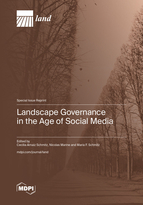Landscape Governance in the Age of Social Media
A special issue of Land (ISSN 2073-445X). This special issue belongs to the section "Landscape Ecology".
Deadline for manuscript submissions: closed (30 November 2022) | Viewed by 27733
Special Issue Editors
Interests: social-ecological systems; urban–rural gradients; land planning; simulation scenarios; landscape structure; global change; socioeconomic models
Special Issues, Collections and Topics in MDPI journals
Interests: heritage management; cultural landscape; new media studies; cartography
Special Issues, Collections and Topics in MDPI journals
Interests: cultural landscape; social–ecological systems; landscape heritage; biocultural diversity; protected areas; nature-based tourism; landscape structure
Special Issues, Collections and Topics in MDPI journals
Special Issue Information
Dear Colleagues,
At the end of the 20th century, documents like the World Heritage Guidelines or the European Landscape Convention proposed new and challenging ways of conceptualizing landscape assessment and governance. Consequently, in the last two decades, numerous countries have reevaluated their national planning systems and landscape conservation policies.
During the same time, social media has grown into an extensive source of data with a certain influence on how we regard spaces. Currently, numerous researchers are advocating the value of social media data to better comprehend ecosystem services provision, their use, and its intensity. Through this, we may also better comprehend how to recognize people's patterns of behavior, or how they perceive the landscape.
The relation between social media and current conceptualizations of landscape allows for pertinent questions: Is social media useful for administrations to recognize and adapt to changes in land use, patterns of mobility, or landscape meaning? Is it bringing a more democratic understanding of the landscape and its conservation? Does it serve local communities to express their feelings towards governance policies? Do any of these factors align with the concepts laid out by international organizations like the IUCN, UNESCO, or the European Council?
We invite you to delve into the relationship between contemporary forms of landscape valuation and governance and current social media. Possible lines of research include current connections of social media with:
- Traditional ecological knowledge (TEK) and governance decentralization;
- Participatory scenario and land planning based on online technologies;
- Multi-scale processes andsocial–ecological resilience;
- Spatio–temporal patterns for the maintenance of the living landscape;
- Sustainable governance and rural landscape stewardship;
- User generated content (UGC) as a tool for landscape studies;
- Inclusive and participatory land governance—a cross-country comparison.
Kind regards,
Dr. Cecilia Arnaiz Schmitz
Dr. Nicolas Marine
Prof. Dr. María F. Schmitz
Guest Editors
Manuscript Submission Information
Manuscripts should be submitted online at www.mdpi.com by registering and logging in to this website. Once you are registered, click here to go to the submission form. Manuscripts can be submitted until the deadline. All submissions that pass pre-check are peer-reviewed. Accepted papers will be published continuously in the journal (as soon as accepted) and will be listed together on the special issue website. Research articles, review articles as well as short communications are invited. For planned papers, a title and short abstract (about 100 words) can be sent to the Editorial Office for announcement on this website.
Submitted manuscripts should not have been published previously, nor be under consideration for publication elsewhere (except conference proceedings papers). All manuscripts are thoroughly refereed through a single-blind peer-review process. A guide for authors and other relevant information for submission of manuscripts is available on the Instructions for Authors page. Land is an international peer-reviewed open access monthly journal published by MDPI.
Please visit the Instructions for Authors page before submitting a manuscript. The Article Processing Charge (APC) for publication in this open access journal is 2600 CHF (Swiss Francs). Submitted papers should be well formatted and use good English. Authors may use MDPI's English editing service prior to publication or during author revisions.
Keywords
- user-generated content (UGC)
- social media
- cultural landscapes
- landscape governance
- participatory processes
Related Special Issue
- Landscape Governance in the Age of Social Media (Second Edition) in Land (2 articles)








